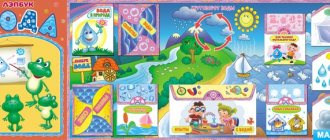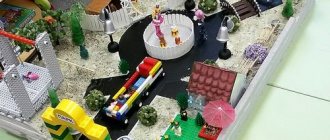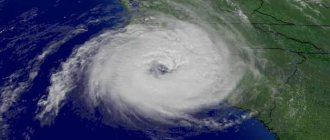eburghostel.ru
Relevance of the project:
The main task of environmental education is to instill in children kindness and humanity, careful treatment of nature, people, oneself, a vision of beauty, and instilling a sense of responsibility, first of all, for one’s own behavior and actions.
The heightened attention of the world community to environmental problems, the solution of which determines the future of humanity, and of each person individually, became the reason that prompted us to form in preschoolers an idea of the world, the importance of water in human life, their interconnection and interdependence.
Objective of the project:
generalize and expand knowledge about fish.
Project objectives:
Educational:
- to form in children ideas about fish as living creatures living in water;
- to develop children's knowledge about the characteristic structure of fish: body shape, fins, gills, etc.;
- develop cognitive abilities in children, actively involve them in creative and exploratory activities.
Educational:
- develop imagination and creativity;
- develop the ability to independently draw conclusions based on observations;
- develop the ability to establish cause-and-effect relationships of various types;
- develop cognitive skills through experimental activities.
- activate and enrich children's vocabulary.
Educators:
- to cultivate an ecological culture, to show the diversity and beauty of the surrounding world.
- to evoke a desire to take care of the riches of nature, to understand that only then will there be a lot of fish in the reservoirs, when the water in them becomes clean, and each fish will have the opportunity to leave offspring;
- cultivate an interest in nature.
Corrective:
- develop the ability to speak while exhaling (smooth speech exhalation);
- develop coherent speech, the ability to compose a story according to a given plan, descriptive stories;
- develop general, fine, articulatory motor skills.
Project participants:
- children 5-6 years old (older age);
- educators;
- teacher speech therapist.
Project type:
information-practice-oriented.
Information, knowledge, impressions received by children in the classroom and in everyday life are reflected in various types of children's activities - play, visual and artistic creativity, in the creation of exhibitions and expositions with the active participation of preschool teachers.
Expected Result:
- to form in pupils an idea of the diversity of the inhabitants of water bodies;
- consolidate and clarify children's knowledge about the appearance of fish, its methods of movement and methods of protection from enemies.
Project Implementation Plan
| Term | Activities of teachers | Pupils' activities | Result |
| September October | Selection of literary works about fish | Reading, memorization | Decorating a book corner. |
| Selection of reproductions of paintings, postcards, photographs | Review, discussion | Organization of a photo exhibition | |
| Selection of video library “Reservoir Inhabitants” | Viewing and discussion of video material | Creating a video library | |
| Conversation on the topic: “The life of fish” | Drawing up tables and diagrams “Power circuits” | Exhibition of works “food chains of water inhabitants”. | |
| Collection of natural material for productive activities | Collection of natural material | Panel “Fishes” SLIDE 2 | |
| Manufacturing of the breathing simulator “Aquarium” | Using a breathing simulator during classes. | SLIDE 3 | |
| November December | Reading fiction on the topic “Fish”: B. Zakhoder “About the catfish”, Russian folk tale “At the command of the pike”, A.S. Pushkin “The Tale of the Goldfish”, Permyak “The First Fish”, I. Tokmakova “Where the Fish Sleeps”. | Conversations on the works read | Quiz on works |
| Conversation “Why does a fish need fins and a tail?” | Didactic game “What is missing”. | Exhibition of drawings “The Magical World of Fish” SLIDE 4 | |
| Conducting a series of speech therapy classes on the topic: “Pisces” | Carrying out speech therapist tasks in home notebooks. | Consolidation of acquired knowledge on the topic. SLIDE 5,6 | |
| January February | Complex lesson “Goldfish” | Origami and leaf applique “Goldfish” | Exhibition of crafts SLIDE 7,8 |
| Complex lesson “Colorful fish” | Creation of a collective composition (sculpting) | Exhibition of works SLIDE 9 | |
| March, April | Conversation “My dad and I are fishing” | Children's stories about fishing | Album design “Catch a Fish” SLIDE 10 |
| May | Complex lesson “Seabed” | Creating a collective composition from natural materials (shells, stones) | Exhibition SLIDE 11 |
| Conversation “Ah, summer!” | Children's stories about holidays on reservoirs (about the inhabitants of reservoirs), the creation of drawings and text for them | Book decoration and exhibition |
Project results.
During the implementation of the project, children formed ideas about the diversity of inhabitants of reservoirs. This can be seen in the results of the joint activities of teachers and children.
- Children have an idea of the appearance of fish.
- Children know how fish move and how to protect them from enemies.
- In the process of working on the project, we studied the habitat of fish in more detail and examined the food chains of the inhabitants of reservoirs.
Literature
- Boykova S.V. Classes with a speech therapist on the development of coherent speech in children 5-7 years old. SPb.: KARO, 2010
- Golub V.T. Graphic dictations. - Moscow. WAKO, 2009
- Zhukovskaya R.I. and Penkova L.A. Reader for children of senior preschool age. Compiled by: R.I. Zhukovskaya, L.A. Penevskaya. Ed. “-e, reworked. and additional M.: “Enlightenment”, 1972. 415 p. with ill. For reading O. Krieger “Goldfish”
- Complex classes according to the program edited by M. A. Vasilyeva, V. V. Gerbova, T. S. Komarova. Senior group / author. – comp. N.V. Lobodina. – Volgogrvd: Teacher, 2011. – 364 p. Application “Beautiful fish in an aquarium” p. 190
- Komarova T. S. Visual arts classes in the senior group of kindergarten. Lesson notes. – M.: Mozaika-Sintez, 2009. – 128 pp.: color. On |Drawing according to the plan p. 55 Modeling according to the plan p. 72
- Complex classes according to the program edited by M. A. Vasilyeva, V. V. Gerbova, T. S. Komarova. Senior group / author. – comp. N.V. Lobodina. – Volgograd: Teacher, 2011. – 364 p. Conversation. What do we know about fish? P. 158
- Lykova I. A. Visual activities in kindergarten: planning, lesson notes, methodological recommendations. Senior group. – M.: “KARAPUZ-DIDACTICS”, 2006. – 208 p., 16 sheets. on Application made of colored paper (collective) “Our Aquarium” p. 194 No. 90 Collective modeling “Swimming on the sea...” p. 180 No. 83 Collective drawing according to the plan “Marine ABC” p. 178 No. 82
- Nishcheva N.V. Notes of subgroup speech therapy classes in the senior group for children with ODD. – SPb.: CHILDREN'S PRESS, 2010
- Novikova I.V. Application from natural materials in kindergarten. To help educators and parents./ I. V. Novikova; artist E. A. Afonicheva - Yaroslavl: Development Academy, 2010. - 80 pp.: - (Kindergarten: day after day). Lesson 12 “A fish swims in a pond” p. 39
- Petrova M.I. “Volume application” p. 33
- Chevychelova E.A. Visual gymnastics for children 2-7 years old, Volgograd: Teacher, 2012
Annex 1
Diagnostic conversation questions.
| Questions | Levels | ||
| High | Average | Short | |
| 1. Where do fish live? | |||
| 2. What fish do you know? | |||
| 3. Why do fish need fins and a tail? | |||
| 4. What do fish eat? | |||
| 5. How do you understand the proverb “You can’t pull a fish out of a pond without difficulty” | |||
| 6 Is it possible to throw garbage into water bodies? Why? | |||
1/11/17
River fish.
Sturgeon
- A member of the sturgeon family. Their meat is highly valued, and an even more valuable product is the famous black caviar. Distributed exclusively in the Northern Hemisphere. There are 12 species in Russian waters.
On the body there are 5 longitudinal rows of bone scutes - bugs; the snout is elongated, with a small transverse toothless mouth. They stay near the bottom and feed on various animal foods: fish, shellfish, worms, insects.
Beluga
is the largest freshwater fish in the world
, they can be up to 118 years old, during which time they never stop growing.
The largest beluga reached 7.4 meters in length and weighed 1570 kg
.
Salmon
Salmon are valuable commercial fish. They are hunted for valuable red meat and red caviar. Salmon live in the fresh waters of the Northern Hemisphere. The largest spawning grounds are located in Kamchatka, Sakhalin and the Kuril Islands.
Salmonidae
Body length - from a few centimeters (whitefish) to 2 meters. Weight - up to 70 kg (salmon, chinook salmon, taimen). Life span is several years; in some species, the average life expectancy reaches 15 years. The record holders for size and life expectancy (over 50 years) are taimen - a fish weighing 105 kg and 250 cm long was reported.
They breed only in fresh waters; most rise to spawn from the ocean or lakes into rivers and streams (migratory fish). Almost all migratory salmon spawn once in their lives and die after spawning.
Before spawning, the body of salmon fish acquires bright colors, red and black spots appear, and males often develop a hump. The jaws become hook-shaped and the teeth become larger. The stomach, intestines and liver stop working, the meat becomes less elastic and fatty and, accordingly, less valuable.
Carp
- Representative of the carp family. The body is usually covered with scales, the head is bare, the mouth is toothless, but the lower pharyngeal bones are well developed and have 1, 2 or 3 rows of teeth. Distributed throughout the Earth, except South America. They feed on living and dead plant and animal foods.
Mirror carp
Carp
Some cyprinids are bred in ponds (carp, crucian carp), and many are used as commercial fish (roach, bream, carp, silver and gold crucian carp, tench, ide, sabrefish).
Pike
Representative of the pike family. Distributed in fresh waters of Eurasia and North America. It usually lives in the coastal zone, in aquatic thickets, in stagnant or weakly flowing waters.
Pike is quite widely bred in pond farms. This fish is also an important target for sport and recreational fishing.
Pike meat contains 2-3% fat and is a dietary product.
The maximum age of pike caught commercially does not exceed 25 years.
Representative of the catfish family. Bottom fish. Lives in rivers and lakes of the European part of Russia and in Europe. Body length up to 5 m, weight up to 400 kg.
The body is covered with bare skin, scales and bone plates are absent, the tail is usually much longer than the body and compressed laterally. On the head there are a pair of maxillary antennae and one or two pairs of mandibular antennae. The color is brown-green. Sometimes, very rarely, albino catfish are found.
Perch
Representative of the order Perciformes. Some of the fin rays look like sharp spines; the pelvic fins are usually located under the pectoral fins, and sometimes in front of them.
Piranhas
They live in rivers and reservoirs of South America. They are distinguished by powerful jaws and sharp fangs. They reach a length of 80 cm and a weight of up to 1 kg. Piranhas are capable of making various sounds. When they are removed from the water, they begin to “bark”, and during fights for food they make low, drum-like sounds. When one fish swims too close to another, they may croak.
Slide 1
Annual project THE AMAZING WORLD OF FISH Completed by: Student 1B grade Kosolapov Pavel Kirovsk 2016
Slide 2
Slide 3
Where I collected information about fish: I went fishing with my dad. I looked for information on the Internet, on Wikipedia. I read books (V. Svechnikov. Fishes. Encyclopedia, Butterfly over the Bay by T.A. Kudryavtsev). I watched “Educational films for children and more”, “Life on Planet Earth. Fish." and the cartoon “Move Your Fins”, “Nemo” I watched the program “Dialogues about Fishing”.
Slide 4
Types of natural inhabitants: 1. Fish are sea, river and lake. 2. Cartilaginous (shark, sea fox) and bony (pink salmon, perch, Napoleon fish) 3. Predatory (pike, perch, pike perch, catfish) and peaceful (silver carp). 4. Big and small. 5. Poisonous (puffer fish and fugu) and healthy (shark meat is very healthy and rich in vitamins). 6. Dangerous and safe.
Slide 5
Fish of the Leningrad Region According to Wikipedia, more than 80 species of fish are found in the waters of the Leningrad Region. Fish adapt very well to different conditions. Thanks to this, they were able to populate seas and oceans, rivers and lakes, ponds and streams.
Slide 6
Mysterious structural features of fish Do you know that many fish have good eyesight, but they do not have eyelids. They even sleep with their eyes open. Some fish lie on their sides. Most fish have eyes located on both sides of the head, and the fish can see with each eye separately: it sees immediately in front of it, behind it, and below it. Most fish swim forward, bending their body in waves. Fins help them move: caudal and lateral. It is easier for a fish to swim if its body has an elongated shape. Just like people, fish can breathe, when a fish swallows water, the water passes through the gills. The gills absorb oxygen and then expel water through external slits behind the eyes. There are also flying fish. Jumping out of the water, they soar on elongated fins, leaving the predator far behind.
Slide 7
Structure of fish
Slide 8
Fish are good at hiding, and their coloring helps them do this. They can hide near a stone or among algae so that they are completely invisible. The hedgehog fish is covered with long needles. And the digger fish loves to dig in the ground. Do you know how long fish live? (from 5 to 100 years!) Small fish live less, but large fish (pike, catfish) can live to a ripe old age. After all, they have no enemies in reservoirs. If they do not get caught by a fisherman, they will live a very long time.
Slide 9
Mysterious facts from the life of fish: There are fish that you don’t feed with bread, just let them walk on the ground. Thus, a small fish called Anabas lives in the freshwater reservoirs of South Asia. After leaving the pond, she is able to calmly “walk” in the fresh air for 6-8 hours. In search of food, Anabas can “move” from one puddle to another or climb a tree. Its fin bones are very strong, and for breathing there is a special organ in the form of a labyrinth, so the duration of the walk sometimes reaches 8 hours.
Slide 10
What do fish eat? According to the way they feed, fish are divided into predatory and peaceful. Carnivores are those that eat other fish, as well as some animals and birds. Predatory fish include pike, perch, pike perch, catfish, burbot, beluga, chub, etc. Peaceful fish eat worms, crustaceans, mollusks, insects and their larvae and, in addition, partially feed on plants. However, there are few pure plant fish. Their most typical representatives are grass carp and silver carp. Peaceful fish usually have no teeth in their mouths, and the mouth itself is relatively small. For the most part, predatory fish have a very large mouth and are armed with teeth.
Slide 11
Dangers to fish? 1. The main danger for fish is that they will be caught by fishermen using a fishing rod or net. 2. An important danger for fish is that it will become food for predatory fish. 3. Fish die due to pollution and drying out of the reservoir.
Slide 12
Interesting things from books: From the book “Butterfly over the Bay” I learned that in our reservoirs there is a small beautiful fish named Ukleya. Its scales have a silvery-metallic color and are delicate and not at all prickly. The scales are so weakly attached to the body that they fly off when touched and stick to the hands. Previously, Russian merchants sold these fish scales to Germany. There they made artificial pearls from it.
Slide 13
Monument to the fish Stickleback: During the Leningrad blockade, stickleback saved the lives of thousands of people. In Kronstadt, on the wall of the Obvodny Canal near the Blue Bridge, a touching monument was erected to this “siege little fish that helped people survive.”
Slide 14
My hobby is fishing: My dad and I really love fishing, especially pike!
On the screen Slide 1. - Guys, today we will talk to you about fish. What do you know about them? What are they? (children's answers) On the screen Slide 2. Fish are aquatic inhabitants whose bodies are covered with scales. On the screen Slide 3. The body of a fish consists of a head, body, tail and fins. On the screen Slide 4. With the help of fins, fish turn in the water and change direction. The tail serves as a rudder for them. On the screen Slide 5. Fish breathe using gills. They close their gills and take a mouthful of water, and then open their gills and release water through them, “taking” oxygen from the water. On the screen Slide 6. Most fish spawn. Each egg then produces fry. They don't look exactly like adult fish. But a little time will pass and the fry will turn into adult fish. On the screen Slide 7. In winter, when the water freezes, the fish sink to the bottom. At this time, they lead a sedentary lifestyle and eat little. But there is very little oxygen in the water under the ice, so people make ice holes to make it easier for the fish to breathe. On the screen Slide 8. - And now, guys, let's talk to you about river fish. On the screen Slide 9. Crucian carp is a river fish, ranging in size from 30 to 50 cm. There are gold and silver crucian carp. On the screen Slide 10. Perch is a small river fish up to 30 cm long. Despite the fact that it is small, perch is a predatory fish. On the screen Slide 11. Ruff is a small fish that feeds on small organisms - crustaceans, etc. Ruff is found in rivers and lakes, and is prey for larger fish. On the screen Slide 12. Catfish is a very large fish, up to 5 m long and weighing up to 300 kg. Catfish live in rivers and lakes. This fish has no scales. Catfish is a predator. On the screen Slide 13. Pike is a river predatory fish, it reaches a length of up to 2 m and weighs more than 60 kg. The color of the pike is speckled gray-green. Pike is very voracious. It feeds mainly on fish, frogs, and insects. On the screen Slide 14. - Let's remember what river fish you have just met? (children's answers) - Now, let's talk to you about sea fish. On the screen Slide 15. Swordfish is one of the largest predatory fish. It reaches 4.5 meters in length and weighs up to 500 kg. It has a large semi-lunar fin on its tail, its upper jaw carries a sword, and its body is naked, without scales. On the screen Slide 16. Monkfish is a large fish up to 1.5 m long and weighs up to 20 kilograms. On the head there is a fishing rod - an appetizing glowing “bait” for other fish. On the screen Slide 17. Flying fish are small, from 15 to 25-35 cm. Even a giant flying fish is no longer than 50 cm. Its pectoral fins are slightly shorter than the body and contain a large number of rays. On the screen Slide 18. The electric stingray is a large fish, often reaching a length of 2 m and a weight of 100 kg, with an almost round body disk and bare skin, devoid of spines and thorns. They use their formidable weapons mainly to kill prey and, of course, for defense. On screen Slide 19. Zebra fish is a saltwater fish colored with cream and burgundy stripes. The body of the zebra fish is equipped with a large number of fins, spines and other appendages. In a moment of danger, she quickly turns from side to side, trying to stand with her back to the enemy, and hits him with her dorsal fins. Lionfish venom is extremely dangerous. - Well, guys, we introduced you to two types of fish. Remind me what types of fish exist? (children's answers). Well done, which fish can we classify as river and which as sea?
This wonderful world of fish
Head: Dryutova Irina Petrovna
primary school teacher MBOU OOSH village. Nikolskoye
Tasks
:
- Study in more detail the structure and life of fish.
- Get to know the characteristics of these animals.
- Conduct an experiment to determine the age of fish and research.
Survey results:
Most often, the guys named the fish that live in our reservoirs: pike, perch, roach, bream and others. But the answers also included fish that do not live in our area, for example, shark, stingray, yellowwing and others. But the answers included not only fish, but also animals: whale, dolphin.
Conclusion:
Analyzing the answers to the questionnaire, I saw that the students of our school made many mistakes; they know little information about fish. I decided to study these amazing animals - fish - in more detail.
Studying the characteristics of fish
- Ichthyology
is the science of fish (in Greek “ichthys” means fish, and “logos” means word, mind).
- Fish
are animals that live in water.
Their body is covered with scales
, they breathe
with gills
and have paired limbs in the form of
fins.
Structure of fish
TAIL
HEAD
TORSO
The body of fish may be naked
, covered with
mucus
,
scales
or
shell
(pipefish). The scales grow with the fish.
Body Shape
in fish it is associated with living conditions.
Fish that live in the water column (salmon) usually have a torpedo- or arrow-shaped shape.
Bottom-dwelling fish most often have a flattened or even completely flat body shape, for example, flounder.
Species that live among aquatic plants, stones and snags have a strongly laterally compressed body, like a bream, or a serpentine body, like an eel, which provides them with better maneuverability.
Fish nutrition
Based on their diet, all fish can be divided into several groups:
- herbivores
- carnivorous
- carnivores that eat fish.
The most voracious are herbivorous fish.
There are no purely herbivorous fish in our reservoirs. Roach, crucian carp, and tench consume animal food along with plant foods.
Fish reproduction
Most fish reproduce by spawning, but some fish are viviparous. For example, guppy fish and sharks.
There are very interesting fish that make nests for their offspring. I know of a stickleback living in Lake Ladoga. The gourami fish also builds a nest.
Habitat.
Fish live in
ponds streams rivers lakes seas oceans
The color of the fish also depends on its habitat. The fish have a dark back and a light belly, which means they will be little noticeable against the background of the bottom when viewed from above. And if the sides and belly are shiny silver, this makes the fish invisible against the background of a light sky or the glare of the sun when viewed from below.
Experiment “Determination of age in fish”
The outside of the fish's body is covered with scales, which protect the body of the fish. There are rings on the scales. Each ring corresponds to one year of the fish's life.
There are several ways to determine the age of fish:
- by scales,
- along the gill cover,
- by cutting bones and others.
I determined the age of fish by their scales using a microscope.
I washed the scales properly.
I let it dry.
I polished it with sandpaper.
He put it on a microscope slide and started looking at it.
I saw the fish have one large ring and many small ones, which means our fish are only 1 year old.
This is what scales look like under a microscope.
Study 1. “Comparison of fish from the Voronezh River, Lake and the Setma River”
- Hypothesis: “It is believed that the size of the reservoir limits the maximum size of the fish that it can reach. The larger the reservoir, the larger the fish that live in it.”
- Proof :
I took two fish - roaches. One fish was caught in the Voronezh River, and the other in the river in our village, Setma.
The age of the fish was the same – 1 year. But the size of the fish was different.
Fish caught in the Voronezh River
Length from head to tail
Fish caught in the Setma River
Body length
Body width
Tail width
Conclusion:
Thus, I saw that the hypothesis was correct.
It has been experimentally proven that the main factor is not so much the volume of the reservoir, but the development of the food supply and water quality. This means that the more food there is in the reservoir, the larger the fish grows.
- For this research, my dad and I went fishing on our lake. We managed to catch the following fish:
- Roach
- Perch
- My question: “How can you help fish in winter?”
- The teacher advised me to let air flow in for the fish, boil the holes, and then throw food into these holes. That's what I did.
Conclusion
After doing my research, I learned:
- determine the age of the fish;
- I can tell you the structure of the fish, its habitat;
- learned interesting facts about fish reproduction.
My conclusion:
fish are part of living nature; they are very interesting and amazing creatures. They need our protection. Water is the habitat of fish. Not a single living creature can live without it. It is necessary that people do not pollute water bodies, do not catch rare fish and do not engage in poaching!
Similar articles
Ecdysterone is a powerful stimulus for your anabolism.
What is ecdysterone asteroid?
Can obesity in older people be successfully treated?
Who is Lena Miro where is she from?






